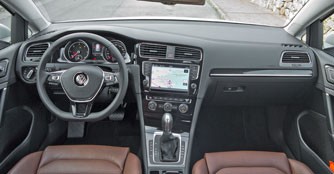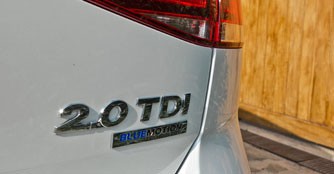Volkswagen Golf 2.0 TDI DSG (A) First Drive Review
03 Dec 2012|29,589 views
With 29 million units of Golf sold since 1974, Volkswagen must be insane to radically change the latest Golf. And in the case of the Mk7, that rings truer than ever before. More evolutionary than revolutionary, the hatchback faces some really tough competition, especially from the likes of the upcoming Audi A3. But in many ways, it's miles ahead of its rivals.
While reviewing just the petrol powered Golf may seem more relevant in the past, things have changed a tad. Thanks to the new diesel rebate tax structure, coupled with the new emission based tax scheme - Carbon Emissions-based Vehicle Scheme (CEVS) - next year in Singapore, reviewing this Golf TDI is probably the most logical and appropriate thing to do.
Exterior
As you may have already read, the Golf is fresh from ground up, utilising the MQB platform that will also be underpinning future Volkswagen models - from the Polo to the Passat to be specific. It's also this platform that has allowed the iconic hatch to save over 100kg and gain more space in its cabin.
Trace the Volkswagen Golf range back through its history and you'll see that there's a clear design lineage. It takes only the swiftest of glances to see that this car is a Golf and that is entirely the point - its instantly recognisable identity is the key to its success.
The body is now more angular than before, with sleeker headlamps that come with U-shaped daytime running lights and sharper tail lamps. Even its fuel lid has been redesigned to complement the car's bolder lines. In a very subtle way, it's these small details that add up to give the car a more premium and classier overall look and feel.
While reviewing just the petrol powered Golf may seem more relevant in the past, things have changed a tad. Thanks to the new diesel rebate tax structure, coupled with the new emission based tax scheme - Carbon Emissions-based Vehicle Scheme (CEVS) - next year in Singapore, reviewing this Golf TDI is probably the most logical and appropriate thing to do.
Exterior
As you may have already read, the Golf is fresh from ground up, utilising the MQB platform that will also be underpinning future Volkswagen models - from the Polo to the Passat to be specific. It's also this platform that has allowed the iconic hatch to save over 100kg and gain more space in its cabin.
Trace the Volkswagen Golf range back through its history and you'll see that there's a clear design lineage. It takes only the swiftest of glances to see that this car is a Golf and that is entirely the point - its instantly recognisable identity is the key to its success.
The body is now more angular than before, with sleeker headlamps that come with U-shaped daytime running lights and sharper tail lamps. Even its fuel lid has been redesigned to complement the car's bolder lines. In a very subtle way, it's these small details that add up to give the car a more premium and classier overall look and feel.
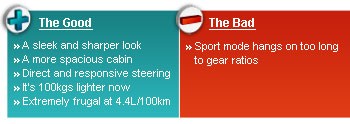 |
Comparing to its predecessor, the length and width have also been gone up by 56mm and 13mm respectively while the height of the car has decreased by 28mm. As a result, the Golf sits more firmly and, perhaps, more aggressively than before.
Whatever the engineers and designers at Volkswagen had in mind, it has definitely worked because the Golf is certainly cohesive, doing without the 'look at me' styling found on some of its more brash competitors.
To put things in a more straightforward and easy-to-relate perspective, the latest Golf is like the girl you met at the Suntec food fair whom you get along really well with, and in hopes that at some point in time, she isn't just an eye candy but is someone you'll fall in love with.
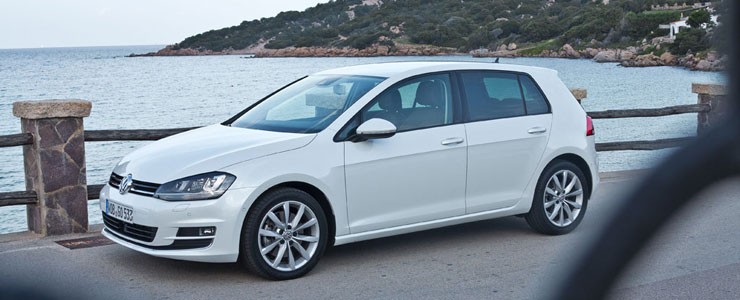 |
Interior
Thanks to its increased dimensions, the new hatch now boasts more room inside, allowing passengers to enjoy greater space than before.
But more notably is its curvier dashboard and more upmarket materials used compared to its previous model. Areas where your hands come into contact with are of high quality while the gloss black fascia and detailing are leagues ahead of anything else in its segment.
Thanks to its increased dimensions, the new hatch now boasts more room inside, allowing passengers to enjoy greater space than before.
But more notably is its curvier dashboard and more upmarket materials used compared to its previous model. Areas where your hands come into contact with are of high quality while the gloss black fascia and detailing are leagues ahead of anything else in its segment.
You wouldn't need a three thousand page owner's manual to know how to operate the buttons and control too. Perhaps the only two things you'll need to get used to is the fact that the traditional handbrake has been replaced with an electronic park brake and the touchscreen display (standard with a 5.0-inch and optional 8.0-incher) has been upgraded. It now has a sensor to display a set of buttons as you move your hands towards it.
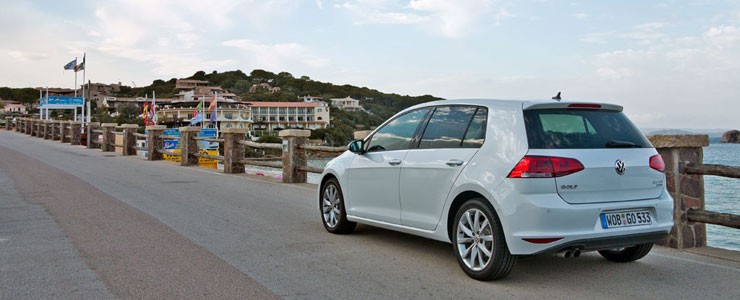 |
Drivetrain
Testing the diesel version of the Golf that you see here was no accident and it certainly wasn't a mistake. Producing a maximum output of 150 horses and 320Nm of torque (the 1.4-litre petrol variant has 140bhp and 250 Nm of torque), the 2.0-litre TDI powerplant will complete the century sprint in a respectable 8.6 seconds.
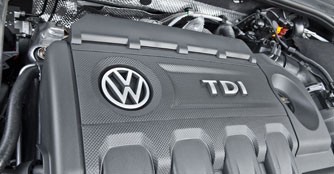
 This 2.0-litre TDI saves more fuel than the smaller 1.4-litre TSI variant - 4.4L/100km vs 4.7L/100km
This 2.0-litre TDI saves more fuel than the smaller 1.4-litre TSI variant - 4.4L/100km vs 4.7L/100km
But of course, more importantly, it delivers the goods with a sense of occasion and impressively smooth civility as well. You'll hear the light diesel clatter from outside during warm up, and a little vibration through the steering wheel on the inside, but otherwise the only things to remind you this is a diesel are positive, in the form of really strong pulling power and the excellent economy of 4.4L/100km - a significant advantage over the smaller displacement petrol variant of 4.7L/100km.
On the go, the responsive steering is direct and it feels planted and surefooted through the bends with very little body roll, thanks to a slightly stiffened suspension set up. The whole set up feels tauter, regardless of your chosen drive and damper settings.
Testing the diesel version of the Golf that you see here was no accident and it certainly wasn't a mistake. Producing a maximum output of 150 horses and 320Nm of torque (the 1.4-litre petrol variant has 140bhp and 250 Nm of torque), the 2.0-litre TDI powerplant will complete the century sprint in a respectable 8.6 seconds.

But of course, more importantly, it delivers the goods with a sense of occasion and impressively smooth civility as well. You'll hear the light diesel clatter from outside during warm up, and a little vibration through the steering wheel on the inside, but otherwise the only things to remind you this is a diesel are positive, in the form of really strong pulling power and the excellent economy of 4.4L/100km - a significant advantage over the smaller displacement petrol variant of 4.7L/100km.
On the go, the responsive steering is direct and it feels planted and surefooted through the bends with very little body roll, thanks to a slightly stiffened suspension set up. The whole set up feels tauter, regardless of your chosen drive and damper settings.
Still, the ride is excellent. The car takes in torn tarmac and smaller potholes with stride while remains to be a very quiet style-mover. Volkswagen has done a great deal of work to improve sound proofing, with external noises kept well at bay.
However, like the petrol variant that we tested in sunny Sardinia, the DSG gearbox hangs on too long to ratios in Sport mode, feeling a little unresponsive to throttle input at some crucial moments. Good thing is - it's effortless around town with controlled and well behaved character that's expected from a Volkswagen. It does make you wonder if you're piloting something larger and more expensive than any direct rivals.
Conclusion
Not only is it the leading car in its segment (with 29 million units, it should be, really), the Mk7 Golf is probably also the most refined hatch in town. With its engaging drive and big car levels of refinery, coupled with the upcoming diesel tax rebate, it's difficult to ignore this car.
After all, it's a Volkswagen Golf.
However, like the petrol variant that we tested in sunny Sardinia, the DSG gearbox hangs on too long to ratios in Sport mode, feeling a little unresponsive to throttle input at some crucial moments. Good thing is - it's effortless around town with controlled and well behaved character that's expected from a Volkswagen. It does make you wonder if you're piloting something larger and more expensive than any direct rivals.
Conclusion
Not only is it the leading car in its segment (with 29 million units, it should be, really), the Mk7 Golf is probably also the most refined hatch in town. With its engaging drive and big car levels of refinery, coupled with the upcoming diesel tax rebate, it's difficult to ignore this car.
After all, it's a Volkswagen Golf.
With 29 million units of Golf sold since 1974, Volkswagen must be insane to radically change the latest Golf. And in the case of the Mk7, that rings truer than ever before. More evolutionary than revolutionary, the hatchback faces some really tough competition, especially from the likes of the upcoming Audi A3. But in many ways, it's miles ahead of its rivals.
While reviewing just the petrol powered Golf may seem more relevant in the past, things have changed a tad. Thanks to the new diesel rebate tax structure, coupled with the new emission based tax scheme - Carbon Emissions-based Vehicle Scheme (CEVS) - next year in Singapore, reviewing this Golf TDI is probably the most logical and appropriate thing to do.
Exterior
As you may have already read, the Golf is fresh from ground up, utilising the MQB platform that will also be underpinning future Volkswagen models - from the Polo to the Passat to be specific. It's also this platform that has allowed the iconic hatch to save over 100kg and gain more space in its cabin.
Trace the Volkswagen Golf range back through its history and you'll see that there's a clear design lineage. It takes only the swiftest of glances to see that this car is a Golf and that is entirely the point - its instantly recognisable identity is the key to its success.
The body is now more angular than before, with sleeker headlamps that come with U-shaped daytime running lights and sharper tail lamps. Even its fuel lid has been redesigned to complement the car's bolder lines. In a very subtle way, it's these small details that add up to give the car a more premium and classier overall look and feel.
While reviewing just the petrol powered Golf may seem more relevant in the past, things have changed a tad. Thanks to the new diesel rebate tax structure, coupled with the new emission based tax scheme - Carbon Emissions-based Vehicle Scheme (CEVS) - next year in Singapore, reviewing this Golf TDI is probably the most logical and appropriate thing to do.
Exterior
As you may have already read, the Golf is fresh from ground up, utilising the MQB platform that will also be underpinning future Volkswagen models - from the Polo to the Passat to be specific. It's also this platform that has allowed the iconic hatch to save over 100kg and gain more space in its cabin.
Trace the Volkswagen Golf range back through its history and you'll see that there's a clear design lineage. It takes only the swiftest of glances to see that this car is a Golf and that is entirely the point - its instantly recognisable identity is the key to its success.
The body is now more angular than before, with sleeker headlamps that come with U-shaped daytime running lights and sharper tail lamps. Even its fuel lid has been redesigned to complement the car's bolder lines. In a very subtle way, it's these small details that add up to give the car a more premium and classier overall look and feel.
Comparing to its predecessor, the length and width have also been gone up by 56mm and 13mm respectively while the height of the car has decreased by 28mm. As a result, the Golf sits more firmly and, perhaps, more aggressively than before.
Whatever the engineers and designers at Volkswagen had in mind, it has definitely worked because the Golf is certainly cohesive, doing without the 'look at me' styling found on some of its more brash competitors.
To put things in a more straightforward and easy-to-relate perspective, the latest Golf is like the girl you met at the Suntec food fair whom you get along really well with, and in hopes that at some point in time, she isn't just an eye candy but is someone you'll fall in love with.
Whatever the engineers and designers at Volkswagen had in mind, it has definitely worked because the Golf is certainly cohesive, doing without the 'look at me' styling found on some of its more brash competitors.
To put things in a more straightforward and easy-to-relate perspective, the latest Golf is like the girl you met at the Suntec food fair whom you get along really well with, and in hopes that at some point in time, she isn't just an eye candy but is someone you'll fall in love with.
Interior
Thanks to its increased dimensions, the new hatch now boasts more room inside, allowing passengers to enjoy greater space than before.
But more notably is its curvier dashboard and more upmarket materials used compared to its previous model. Areas where your hands come into contact with are of high quality while the gloss black fascia and detailing are leagues ahead of anything else in its segment.
Thanks to its increased dimensions, the new hatch now boasts more room inside, allowing passengers to enjoy greater space than before.
But more notably is its curvier dashboard and more upmarket materials used compared to its previous model. Areas where your hands come into contact with are of high quality while the gloss black fascia and detailing are leagues ahead of anything else in its segment.
You wouldn't need a three thousand page owner's manual to know how to operate the buttons and control too. Perhaps the only two things you'll need to get used to is the fact that the traditional handbrake has been replaced with an electronic park brake and the touchscreen display (standard with a 5.0-inch and optional 8.0-incher) has been upgraded. It now has a sensor to display a set of buttons as you move your hands towards it.
Drivetrain
Testing the diesel version of the Golf that you see here was no accident and it certainly wasn't a mistake. Producing a maximum output of 150 horses and 320Nm of torque (the 1.4-litre petrol variant has 140bhp and 250 Nm of torque), the 2.0-litre TDI powerplant will complete the century sprint in a respectable 8.6 seconds.
But of course, more importantly, it delivers the goods with a sense of occasion and impressively smooth civility as well. You'll hear the light diesel clatter from outside during warm up, and a little vibration through the steering wheel on the inside, but otherwise the only things to remind you this is a diesel are positive, in the form of really strong pulling power and the excellent economy of 4.4L/100km - a significant advantage over the smaller displacement petrol variant of 4.7L/100km.
On the go, the responsive steering is direct and it feels planted and surefooted through the bends with very little body roll, thanks to a slightly stiffened suspension set up. The whole set up feels tauter, regardless of your chosen drive and damper settings.
Testing the diesel version of the Golf that you see here was no accident and it certainly wasn't a mistake. Producing a maximum output of 150 horses and 320Nm of torque (the 1.4-litre petrol variant has 140bhp and 250 Nm of torque), the 2.0-litre TDI powerplant will complete the century sprint in a respectable 8.6 seconds.
But of course, more importantly, it delivers the goods with a sense of occasion and impressively smooth civility as well. You'll hear the light diesel clatter from outside during warm up, and a little vibration through the steering wheel on the inside, but otherwise the only things to remind you this is a diesel are positive, in the form of really strong pulling power and the excellent economy of 4.4L/100km - a significant advantage over the smaller displacement petrol variant of 4.7L/100km.
On the go, the responsive steering is direct and it feels planted and surefooted through the bends with very little body roll, thanks to a slightly stiffened suspension set up. The whole set up feels tauter, regardless of your chosen drive and damper settings.
Still, the ride is excellent. The car takes in torn tarmac and smaller potholes with stride while remains to be a very quiet style-mover. Volkswagen has done a great deal of work to improve sound proofing, with external noises kept well at bay.
However, like the petrol variant that we tested in sunny Sardinia, the DSG gearbox hangs on too long to ratios in Sport mode, feeling a little unresponsive to throttle input at some crucial moments. Good thing is - it's effortless around town with controlled and well behaved character that's expected from a Volkswagen. It does make you wonder if you're piloting something larger and more expensive than any direct rivals.
Conclusion
Not only is it the leading car in its segment (with 29 million units, it should be, really), the Mk7 Golf is probably also the most refined hatch in town. With its engaging drive and big car levels of refinery, coupled with the upcoming diesel tax rebate, it's difficult to ignore this car.
After all, it's a Volkswagen Golf.
However, like the petrol variant that we tested in sunny Sardinia, the DSG gearbox hangs on too long to ratios in Sport mode, feeling a little unresponsive to throttle input at some crucial moments. Good thing is - it's effortless around town with controlled and well behaved character that's expected from a Volkswagen. It does make you wonder if you're piloting something larger and more expensive than any direct rivals.
Conclusion
Not only is it the leading car in its segment (with 29 million units, it should be, really), the Mk7 Golf is probably also the most refined hatch in town. With its engaging drive and big car levels of refinery, coupled with the upcoming diesel tax rebate, it's difficult to ignore this car.
After all, it's a Volkswagen Golf.
Thank You For Your Subscription.






























